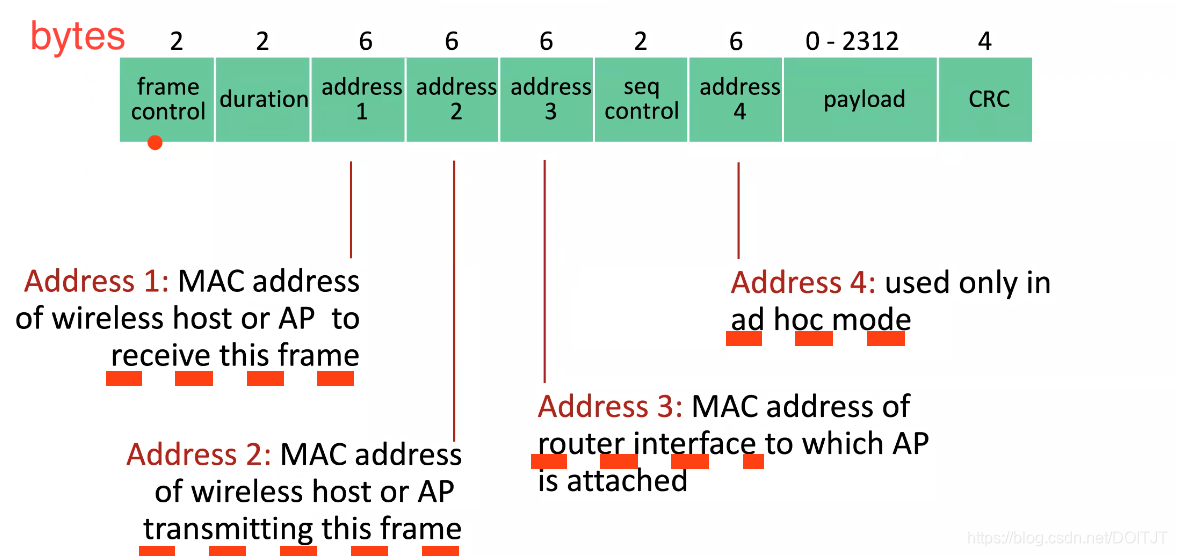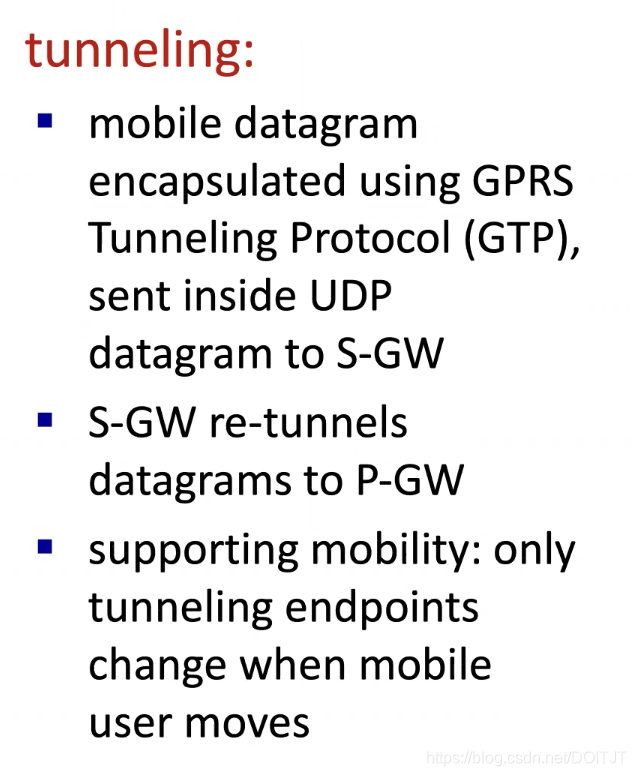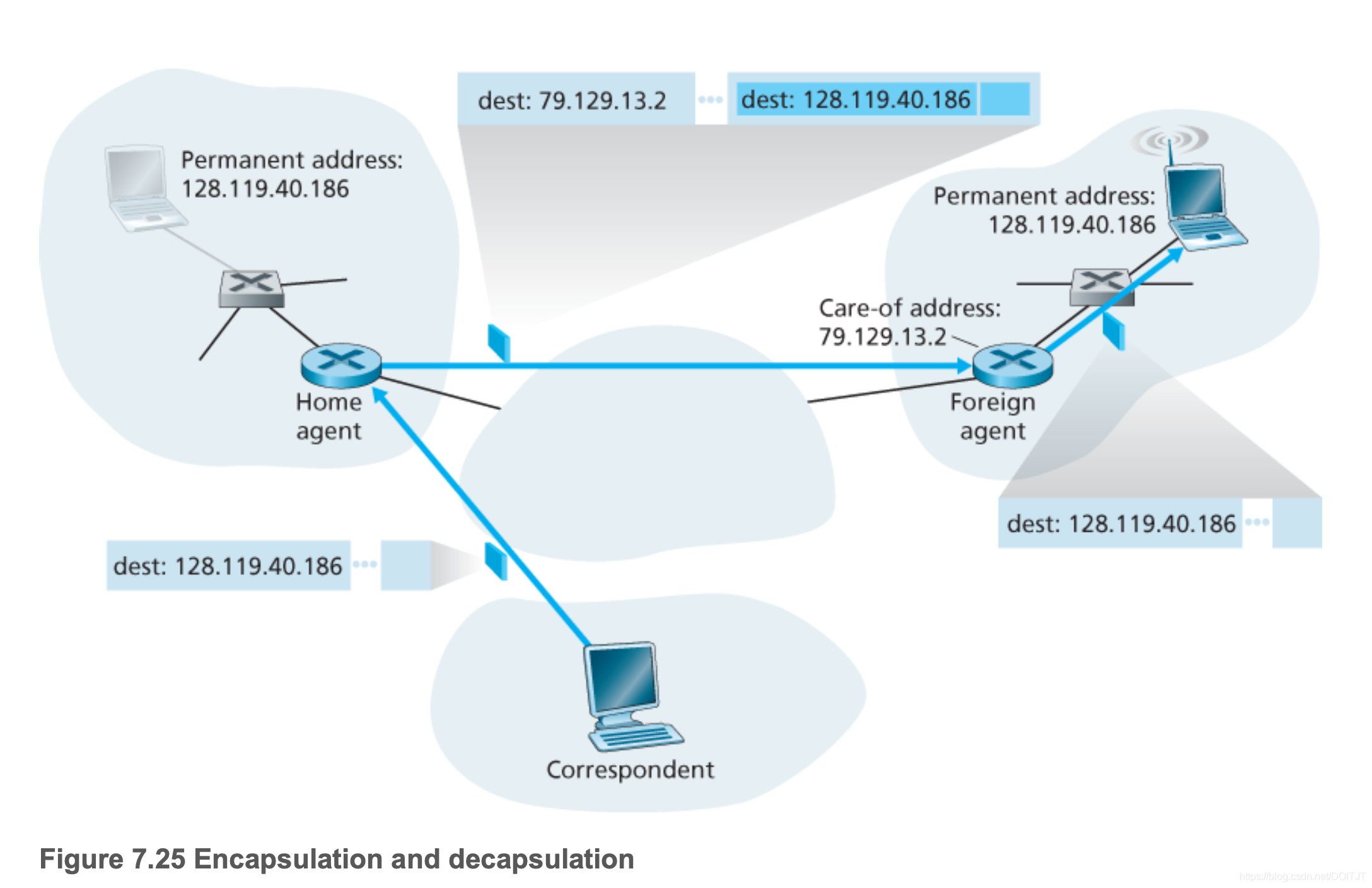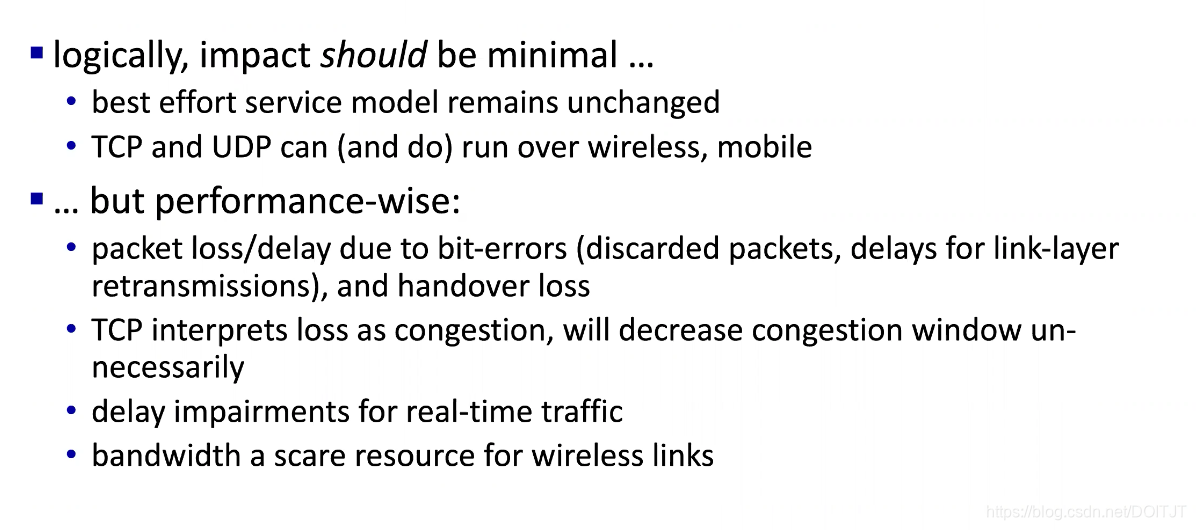- Wireless Hosts: End-system devices that run applications. A mobile host doesn't have to be portable/stationary. e.g. laptop, tablet, smartphone, or desktop computer
- Wireless Link: the link between hosts OR betwen a host and a base station. Links have 2 key characteristics -- coverage area and link rate.
- Base Stations: Wired into the bigger network. Sending and receiving data (e.g., packets) to and from a wireless host that is associated with that base station. e.g. Cell tower, Access points.
- "Association" with a base station: Host is within the wireless communication distance of a base station + Data is relayed from host to the base station into the larger network.
- Handoff: The change of base station when a mobile host move beyond a base station into another.
-
Network infrastructure: the larger network with which a wireless host may wish to communicate.
-
Infrastructure mode: hosts associated with a base station
- Ad hoc network: hosts that are not associated with a base station and thus do their own routing, address assignment, DNS-like name translation, and more. Not connected to the outside, bigger network, but interconnected within the ad hoc network
Network Classification
- Single Hop, infrastructure-based: all communication is between this base station and a wireless host over a single wireless hop. (public wifi, 4G LTE)
-
Single-hop, infrastructure-less: No base station, one of the nodes in this single-hop network may coordinate the transmissions of the other nodes. Not connected to outside. (Bluetooth)
-
Multi-hop, infrastructure-based: Some wireless nodes may have to relay their communication through other wireless nodes in order to communicate via the base station. (Wireless mesh networks, 360 wifi)
-
Multi-hop, infrastructure-less: No base station, nodes may have to relay messages among several other nodes in order to reach a destination. (mobile ad hoc networks, vehicular ad hoc network)
Links and Network Characteristics
- Differences between a wired link and a wireless link:
-
Path loss: Wireless signals (Electromagnetic radiation) attenuates propagating through matter.
-
Interference: electromagnetic noise & same-frequency signals will interfere with one another
-
Multipath propagation: Bounce off objects and the ground, taking paths of different lengths between a sender and receiver. Cause signal blurring at receiver.
-
Wireless networks are more prone to bit errors.
-
Signal-to-Noise Ratio (SNR): Strength of the received signal (i.e., the information being transmitted) vs. Strength of the noise. A larger SNR makes it easier for the receiver to extract the transmitted signal from the background noise.
-
Bit Error Rate (BER): Probability that a transmitted bit is received in error at the receiver.
-
With a given physical layer: Boost signal --> Higher SNR --> Lower BER
-
With a given SNR: pick a physcial layer that provide a wide throughput with low BER.
-
Hidden Terminal Problem: Some physical obstruction prevent 2 hosts from hearing one another, but the signals are interferring at another destination where the signals are not blocked.
-
Signal Attenuation Problem: signals from two hosts attenuates so cannot be detected by one another, but a middleware destination can.
CDMA
Code division multiple access, a channel partitioning protocol
- Chipping code: a dynamic code to encode data
- All users broadcast over the same frequency channel
- Each receiver has the code to decode its own message among the big mess of message transmitted through the channel
WiFi
IEEE 802.11 wireless LAN
- Different 802.11 standards share the same medium access protocol, CSMA/CA, the same link-layer frame structure, all can reduce their transmission rate in order to reach out over greater distances, all backward compatible
- Frequency range
-
2.4 GHz range: unlicensed, compete with microwaves
-
5 GHz range: shorter transmission distance, more multipath propagation
-
-
Antennas
-
“smart” antennas: 802.11ac, adaptively beamform, decreases interference and increases distance
-
(MIMO) antennas: two or more antennas on the sending side and two or more antennas on the receiving side that are transmitting/receiving different signals
-
CSMA/CA senses the wire and if no-one is using it, they it will broadcast onto the frame.
Architecture
-
Basic Service Set (BSS): many wireless stations + 1 AP (access point, base station)
-
Many BSS connect to a switch/router and go to a larger network
-
Each wireless station has a MAC address, each AP has a MAC address, globally unique.
Channels and Association
-
Admin assigns a one- or two-word Service Set Identifier (SSID) to the AP
-
802.11 defines 11 partially overlapping channels.
-
Admin assigns 1 channel to the AP (a channel number).
-
Each mobile device is associated with an AP, which means the wireless device creates a virtual wire between itself and the AP.
-
Once associated with an AP, the device will want to join the subnet by sending a DHCP discovery message into the subnet via the AP in order to obtain an IP address on the subnet
Passive scanning
AP periodically send beacon frames, each of which includes the AP’s SSID and MAC address
Wireless device scans the 11 channels, and selects one of the available APs for association
Active scanning
Wireless device broadcasts a probe frame that will be received by all APs, and chooses one that is available.
Multiple Access Protocol
Avoid instead of detection (It is hard to do collision detection in a wireless environment.)
CSMA/CA = “carrier sense multiple access,” meaning that each station senses the channel before transmitting, and refrains from transmitting when the channel is sensed busy.
SENDER
- Sender check if channel idle
- Channel is idle, send the frame after DIFS (a short time)
- Channel is not idle, chooses a random backoff value using binary exponential backoff, keep sensing for channel idle
- When the channel idle, count down random backoff value + DIFS, then send the packet
- When the channel is not idle, wait
- ACK received, if wants to send another frame, go to step 3; ACK not received, pick a larger backoff value, go to step 3
RECEIVER
Packet OK, wait SIFS then send ACK
Collision avoidance
A mechanism for a sender to reserve for a space in the channel and CA.
-
RTS frame: indicating the total time required to transmit the DATA frame and the acknowledgment (ACK) frame
-
CTS frame: gives the sender explicit permission to send and also instructs the other stations not to send for the reserved duration.
Addressing
Mobility
H1 moves with-in the same subnet (BSS1 --> BSS2): IP stays the same, TCP connection maintained
- H1 moves away from AP1, signal from AP1 reduces
- H1 moves toward AP2, signal from AP2 increases
- H1 dis-associates with AP1, and associates with AP2
- AP2 sends a broadcast Ethernet frame with H1’s source address to the switch just after the new association
- Switch (self-learning) updates the forwarding table to redirect packets to AP2
Advanced Features
Rate Adaptation
A node can change the transmission rate dynamically according to the network situation. This is a mechanism for ensure frames will be delivered successfully.
- High BER (lots of unACKed frames), reduce transmission rate
- Low BER (frames delivered), increase transmission rate
Power Management
A node can set its power-management bit in the header of an 802.11 frame to 1 to indicate sleep.
- AP knows that the node will sleep, stop transmitting frames, wakes up the node before next beacon frame
- Node wake up when beacon frame is sent, fall back to sleep when no more frame comes in
Bluetooth
- Short-range, low-power, low-cost
-
2.4 GHz unlicensed radio band
-
TDM (time slots of 625 microseconds) + FDM (each time slot has 79 channels)
-
Ad hoc: No network infrastructure
-
Piconet: 1 master device and and many client devices. master can transmit to any active device in the network, client can only respond.
-
Parked device are sleeping devices and can be waken up by the master.
4G
- Solution for wide-area mobile internet
- Widespread use
- Rate up to 100's Mbps (usually up to 60, 70)
- All-IP: ONLY IP datagrams are used to carry data from user to the larger internet. (no telephone technologies are used)
- Separates control & data planes
Architecture
- Radio Access Network: Mobile devices connected to base stations
- Mobile devices (User Equipment) have 64-bit IMSI stored on the SIM card
- Base Station (eNode-B)
- Coverage areas known as "Cell"
- Control Plane responsibility: Similar to WIFI AP, BUT coordinate with near-by stations to handle mobility better, handles registeration
-
Data Plane responsibility: Forward datagrams between UE (over the LTE radio access network) and the P-GW. UE datagrams are encapsulated at eNode-B, and tunneled to the P-GW through EPC.
- Enhanced Packet Core (EPC): all traffics are IP based (all IP datagrams)
- Home Subscriber Service (HSS): where info of mobile devices is stored, work with MME in device authentication
- PDN Gateway (P-GW): gateway to the larget internet, provides NAT service.
-
Allocates IP addresses to the UEs
-
Performs QoS (quality of service) enforcemant
-
Performs datagram encapsulation/decapsulation
-
- Serving Gateway (S-GW): gateways on the path from mobile to internet
-
All UE traffic will pass through the S-GW
-
Performs charging/billing functions
-
Performs lawful traffic interception
-
- MME: co-ordinate with HSS to do authentication, track device location, handle cell switching (mobility)
-
Performs connection and mobility management
-
Receives UE subscription information from the HHS
-
LTE link layer protocols


LTE Radio Access Network
Association with a Base Station
Sleep Modes
5G
- Frequency
- FR1 (450 MHz - 6 GHz) & FR2 (24GHz - 52GHz): millimeter wave frequencies
- Higer data rates, shorter coverage distance (pico-cells: 10-100m)
- Needs lots of new stations
- NO backward compatibility with 4G
- Use MIMO (multiple directional antennae), better throughput
Mobility
- Network perspective mobility spectrum
- No-mobility (关掉电脑,从一个地方拿到另一个地方)
- Low-mobility (在一个AP的辖区内移动)
- Med-mobility (在同一个provider内的多个AP间移动)
- High-mobility (在多个provider辖区之间移动)
- Router approach (不可用)
- A device associate with a new network
- New network router broadcast the change
- Other network routers receive broadcast and remove the device from their routing tables
- Problem: not scalable, too many entries in the routing table
Current Approach
-
Home agent in the mobile node’s home network can track the foreign network in which the mobile node resides
-
Foreign agent update the mobile node’s location to the home agent.
-
COA (care-of address)
-
Created by foreign agent
-
Used as foreign address of the mobile device
-
Network portion of the COA matching that of the foreign network
-
eg. Foreign network address: 79.129.13/24, COA: 79.129.13.2
-
-
Indirect Routing
-
Mobile node registers with the foreign agent when attaching to the foreign network
-
Foreign agent will register the mobile node’s COA with the home agent
- Correspondent wants to send a datagram to a mobile node
- Correspondent forwards datagram to mobile node's home agent, using the mobile node’s COA
- Home agent encapsulates the correspondent’s original complete datagram within a new (larger) datagram
-
Foreign agent receives and decapsulates the datagram, and forwards the original datagram to the mobile node.
-
Respond message can either go through home agent or go directly to correspondent
Direct Routing
Indirect routing 绕路,不划算
-
Mobile node registers with the foreign agent when attaching to the foreign network
-
Foreign agent will register the mobile node’s COA with the home agent
- Correspondent wants to send a datagram to a mobile node
- Correspondent agent in the correspondent’s network ask home agent for the COA of the mobile node (the home agent is queried for the COA by the correspondent agent only once, at the beginning of the session)
-
Foreign agent in that foreign network where the mobile node was first found as the anchor foreign agent
-
Correspondent agent then tunnels datagrams directly to the mobile node’s COA
-
Foreign agent receives and decapsulates the datagram, and forwards the original datagram to the mobile node.
If the mobile node moves to another network
-
Mobile node registers with the new foreign agent
-
New foreign agent provides the anchor foreign agent with the mobile node’s new COA
-
Correspondent agent tunnels the datagram to anchor foreign agent
-
Anchor foreign agent re-encapsulate the datagram and forward it to the mobile node using the new COA
-
Repeat Step 1&2 if moves agagin
HandOver
As the signal from the mobile device degrades,
Impact






















